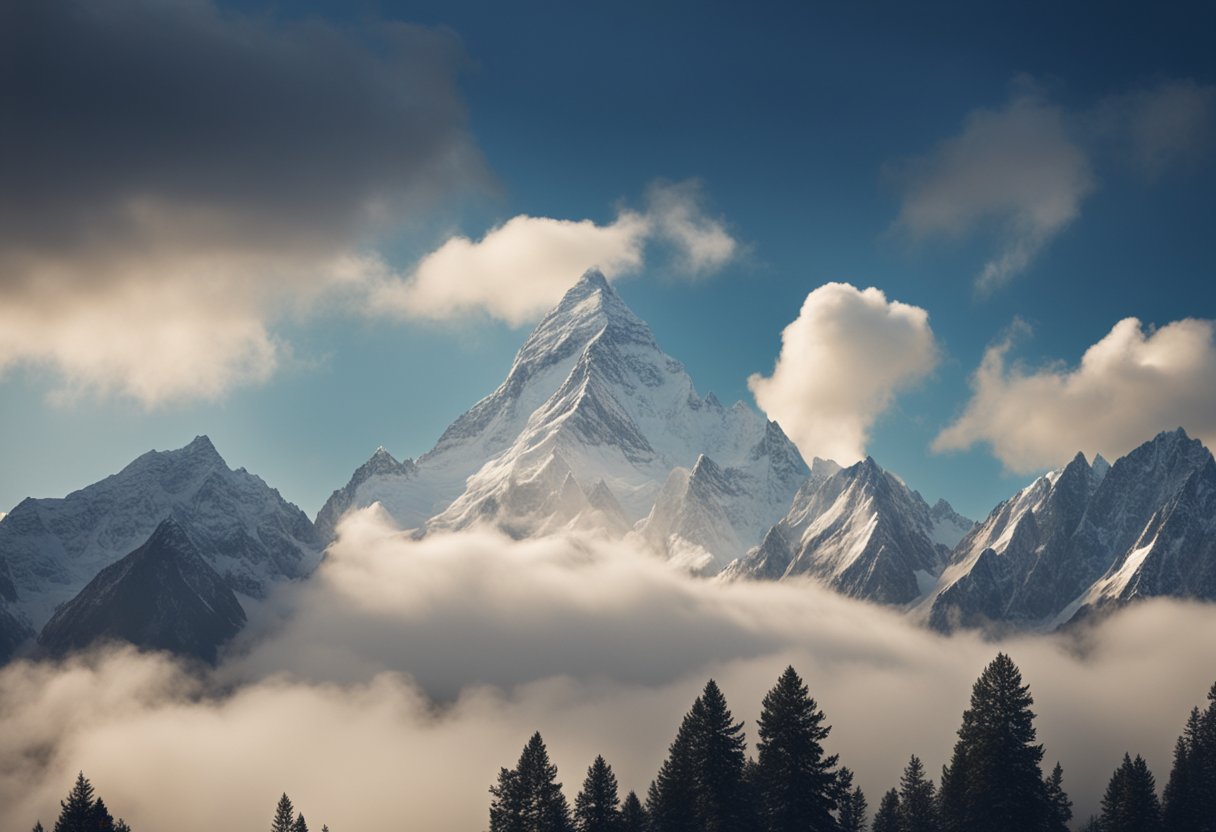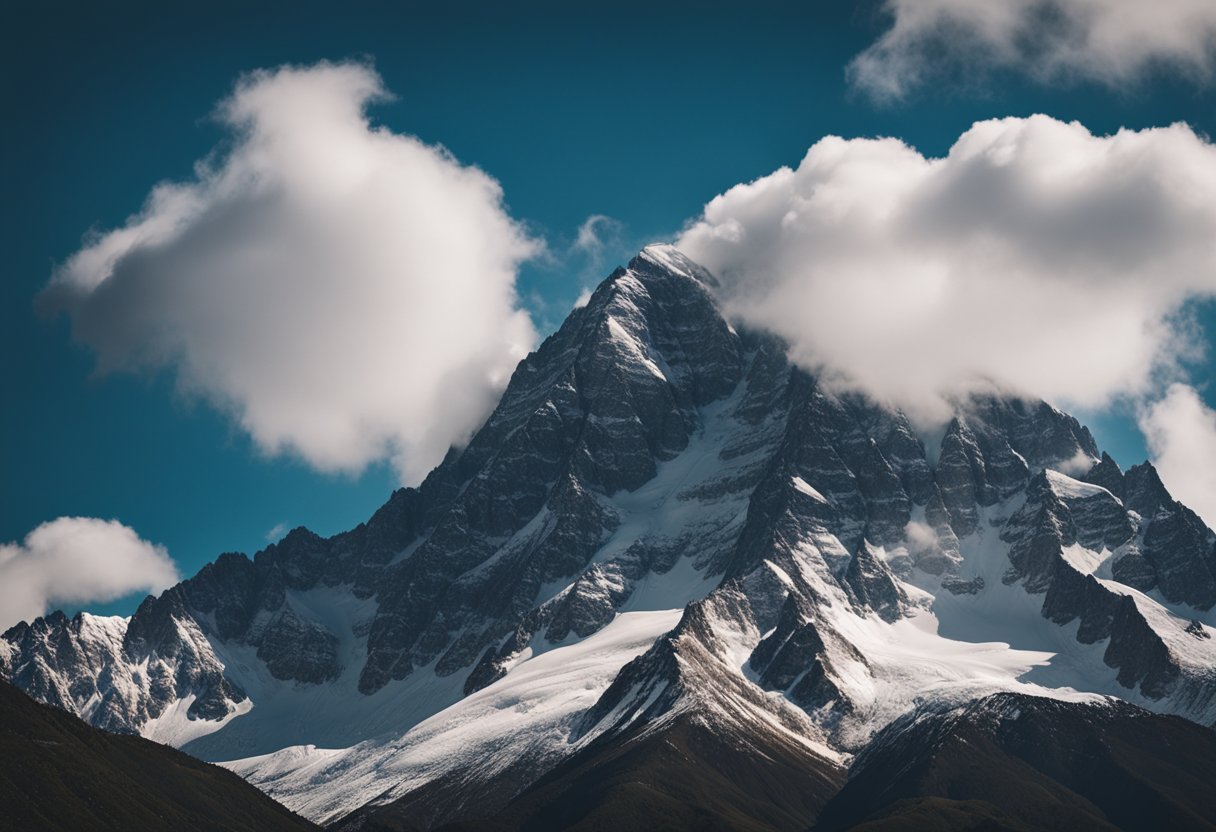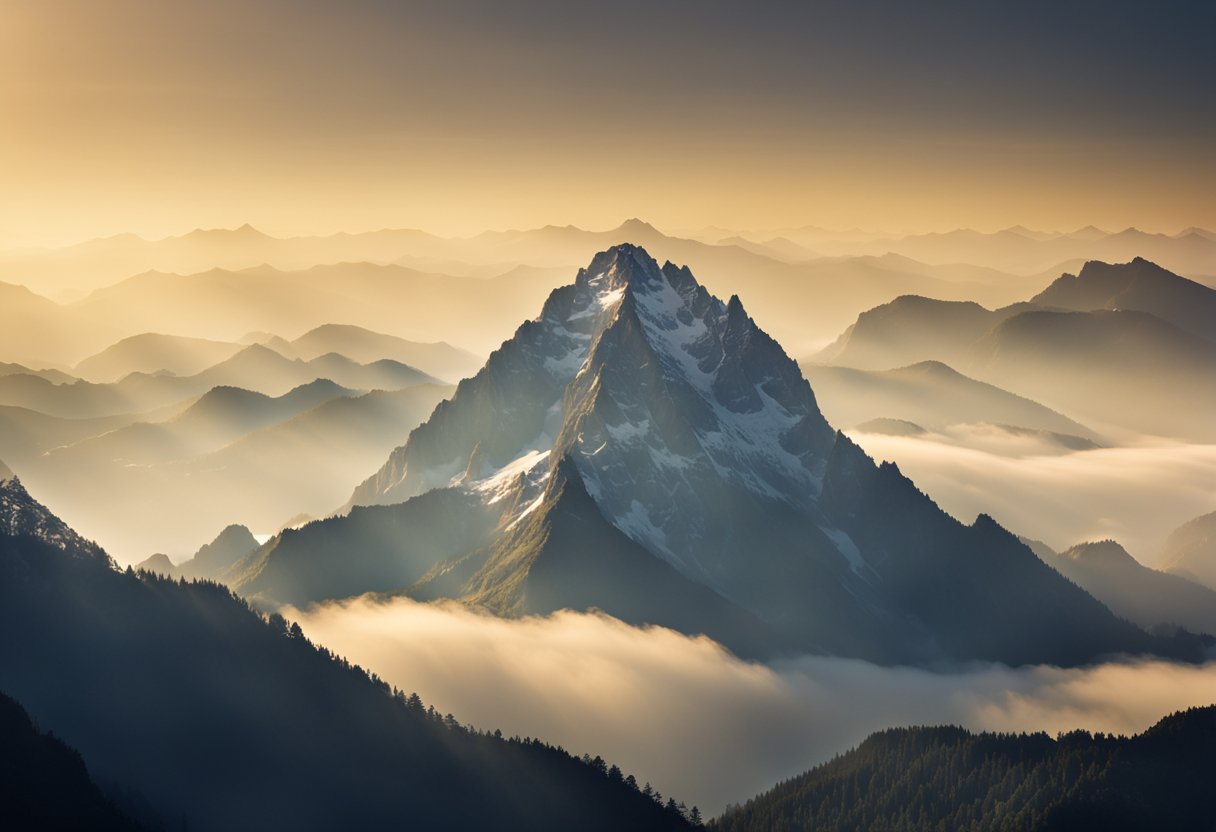The Cultural Significance of Mountains in Religion and Mythology

Updated On: April 22, 2024 by Raghda Elsabbagh
Throughout history and across cultures, mountains have been revered and imbued with spiritual significance. Often viewed as the abode of the divine, these majestic landforms resonate deeply with human beliefs and the very fabric of numerous sacred narratives. Across various religions, mountains have served as quintessential sites for spiritual encounters, forming the setting for profound mythological events and the axis mundi, or world’s centre, in many cosmologies.

Similarly, in mythology, mountains are frequent symbols of eternity, challenge, or the domicile of powerful beings. Their towering presence in cultural landscapes reflects the human fascination with the sublime and the supernatural. Whether they are featured in artistic expressions, woven into the fabric of cultural identity, or are central to environmental ethics, mountains remain an enduring theme in exploring our world’s diverse cultures. How we perceive and interact with these natural marvels is reflective of the geographical and natural importance we ascribe to them, alongside the spiritual and cultural reverence they command.
Table of Contents
Historical Perspectives on Mountains in Mythology
We find that mountains have been emblematic in myths and legends throughout history, often representing transformation, renewal, and the steadfastness of beliefs.
Ancient Myths and Legends
Mountains have consistently appeared across various cultures as places of divine or supernatural significance. In ancient mythology, mountains were often seen as the abode of the gods or as pathways between the earth and the heavens. For instance, Mount Olympus was the legendary home of the Greek gods, and Mount Meru is considered a sacred mountain in Hindu, Buddhist, and Jain cosmology, symbolising the centre of the universe. Each of these myths speaks to a society’s cultural values and its understanding of the divine.
Mountains in Classical Literature
Within the realm of classical literature, mountains have maintained their mystical allure and significance. In texts such as Homer’s Odyssey, mountains serve as formidable landscapes where epic journeys take place, reflecting both literal and metaphorical transformation. Mountains such as the treacherous cliffs of Scylla and Charybdis in these tales are not only geographical challenges but also symbols of personal trials and the pursuit of renewal.
These historical perspectives expose the enduring link between geography and the human quest for meaning through stories and symbolism found in mountainous terrains.
Religious Significance of Sacred Mountains
Mountains have long been venerated in various religious traditions around the world. They are often seen as the abode of the divine, places where heaven and earth meet. These peaks are not just important in geographical terms but are deeply embedded in the spiritual narratives of many faiths.
Mount Sinai and Judaism
Mount Sinai holds profound significance in Judaism as the place where Moses is believed to have received the Ten Commandments. Known as the site where God made a covenant with the Israelites, it remains a symbol of divine revelation and a sacred pilgrimage destination.
Mount Meru in Hindu Beliefs
In Hindu tradition, Mount Meru is considered the centre of all physical, metaphysical, and spiritual universes. It is the abode of Lord Brahma and other gods, representing the axis of Hindu cosmology. The mountain is symbolic of the high spiritual state one aims to achieve in Hinduism.
Mount Kailas and Tibetan Buddhism
Mount Kailas is revered in Tibetan Buddhism as the home of Demchog, a representation of supreme bliss. Pilgrims journey to this sacred site with the belief that circumambulating the mountain will bring spiritual benefits and wash away sins.
Significance of Mountains in Spiritual and Religious Practices
Mountains have long been powerful symbols in spiritual and religious practices, revered as physical connections between the earth and the divine. They are pivotal for pilgrimage, embodying sacredness and offering a place for meditation and finding spiritual power.
Pilgrimage and Spiritual Journeys
Mountains often serve as the focal point for pilgrimages, drawing people from various walks of life seeking spiritual enlightenment or blessings. Sacred peaks are not just geographical landmarks; they’re imbued with awe and respect, seen as abodes of deities or as spaces that provide closer proximity to the spiritual realm. For instance, Mount Kailash is considered holy in Hinduism, Buddhism, and Jainism, with pilgrims embarking on the treacherous journey around its base, a ritual known as a kora, which is believed to bring good fortune and wash away sins.
Rituals and Festivities
Throughout the year, numerous rituals and festivities take place on or around hallowed mountains, reflecting the deep interconnection between the natural world and spiritual practices. These events range from the lighting of sacred fires to the offering of prayers and the performance of ceremonies intended to honour the spiritual essence of the mountain. In some traditions, mountains are also the preferred sites for certain rites of passage, with their elevated stature providing a transcendent backdrop for these meaningful moments in people’s spiritual lives.
Mountains in Artistic Expression

Mountains have long served as muses in the realm of artistic expression, symbolising themes such as transcendence, obstacles, and the sublime. Their imposing presence and grandeur evoke awe and contemplation among artists, influencing a rich tradition of mountain depictions across various media.
Mountains in Visual Arts
In visual arts, mountains have been a central subject for painters, sculptors, and photographers seeking to capture their majesty and the emotional response they elicit. Renowned artists like Caspar David Friedrich celebrated the mountain landscape with works like Wanderer above the Sea of Fog, encapsulating the Romantic period’s fascination with nature’s power and sublimity. In Eastern traditions, scroll paintings frequently feature mountains to symbolise spiritual ascension and the impermanence of life. An example is the intricate brushwork found in Chinese shan shui paintings, highlighting the harmonious relationship between humans and nature.
Literary Depictions of Mountains
In literature, mountains play a significant role in shaping narratives and themes. Poets and authors often harness their symbolic potential to explore human identity and emotions. For instance, in Kubla Khan, Samuel Taylor Coleridge conjures a dreamlike landscape centred around a mountain, reflecting the peaks’ capacity to inspire the imagination. Similarly, in his vivid recounting of a Mount Everest expedition in Into Thin Air, contemporary writers like Jon Krakauer leverage the mountain’s daunting challenge to delve into themes of ambition, survival, and the human spirit.
Mountains and Cultural Identity
Mountains are not just natural formations; they are pivotal in shaping the national and tribal identities of people around the world. They serve as enduring symbols and hold a connection to the cultural narratives and the ancestors of many communities.
National and Regional Symbols
Mountains often form an integral part of a country’s national identity. They are featured on flags, emblems, and in national anthems, serving as a source of pride and unity for the nation. For example, Mount Fuji is a national symbol of Japan, embodying the country’s cultural aesthetic and natural beauty. Similarly, the Matterhorn is associated with Switzerland’s rugged independence and alpine heritage.
- Japan: Mount Fuji is depicted in national art and is pivotal to local folklore.
- Switzerland: The Matterhorn graces promotional materials, signifying the country’s Alpine identity.
Furthermore, regional pride is often centred around mountains, reflecting the distinctiveness of smaller geographical areas within nations. These areas might associate specific peaks with regional heritage and values, which become part of their distinct identity.
Tribal and Ethnic Connections
Mountains also play a crucial role in the identity of various tribal and ethnic groups. They often hold spiritual significance and are tied to the stories of the origins and the ancestors of these communities. Tribes may view mountains as sacred spaces where they can connect with the spiritual realm or essential elements of nature that have supported their livelihoods for generations.
- The Navajo Nation: Considers four sacred mountain ranges as the boundaries of their traditional homeland.
- The Maori of New Zealand: Hold Mount Taranaki as an ancestral peak, integral to their community’s history and identity.
In essence, mountains are far more than landforms; they are powerful symbols of cultural identity, resonating with the shared stories and values of national, regional, tribal, and ethnic groups alike.
Environmental Ethics and Mountain Conservation

In this section, we explore the intricate relationship between the sanctity of mountains and the imperative for their conservation, underpinned by environmental ethics and supported by the dedicated work of scientists and conservationists.
Sacredness and Protection of Nature
Mountains have long been revered as sacred spaces across various cultures. This sanctity compels us to adopt a stance of protection towards these natural wonders. The spiritual significance of mountains often leads to greater conservation efforts, fostering a unique alliance between religious beliefs and environmental stewardship. Sacred mountains, like those discussed in Earth’s cathedrals: Europe’s mountains are cultural heritage, not just natural heritage, exemplify how cultural and religious practices can enhance the protection of biodiversity and ecosystems.
In relation to environmental ethics, there is a strong argument that the inherent value of these sacred regions obliges us to maintain their integrity. The notion of sacredness instils a moral foundation that supports and amplifies conservation efforts. This perspective is vital for the long-term preservation of mountainous areas, ensuring they remain untouched and respected for future generations.
The Role of Scientists and Conservationists
Our collective responsibility for mountain conservation is heavily reliant on the expertise and commitment of scientists and conservationists. These professionals are crucial in understanding the delicate ecosystems of mountains and devising strategies to protect them. Through rigorous research and environmental monitoring, as highlighted in Sacred Mountains and Environmental Conservation: A Practitioner’s Workshop, scientists contribute to the creation of ethically sound conservation practices that balance the needs of the environment with cultural and religious considerations.
Conservationists apply this knowledge on the ground, advocating for sustainable practices that minimise human impact while allowing for the customary and religious activities that regard these landscapes as sacred. They engage with local communities to ensure that conservation measures are congruent with traditional ways of life, bridging the gap between scientific understanding and cultural customs. It is their informed and empathetic approach that truly advances the mission of mountain conservation.
Geographical and Natural Aspects of Mountains
Mountains shape our planet’s geography, creating rich and diverse biomes and significantly impacting our climate and water systems.
Mountain Biomes and Biodiversity
Mountain environments are remarkably diverse, ranging from dense forests at lower altitudes to the barren, icy landscape that often crowns their summits. These vertical biomes support a wide variety of flora and fauna adapted to the changing conditions as altitude increases. For instance, the Montane Coniferous Forests typically feature evergreen trees, whereas the Alpine Tundra at higher elevations has adapted to the harsh, windy conditions with low-lying shrubs and specialized mammals that can survive the thin air and cold temperatures.
Water and Climatic Influence
Mountains play a pivotal role in the distribution of water resources. Rains and snowfall on peaks give birth to numerous rivers and lakes, providing essential water supply for agriculture, hydropower, and domestic use. The rugged landscape of mountains can alter weather patterns, creating microclimates and affecting regional climates. For example, the precipitation that mountains capture helps sustain adjacent forests and valleys, often leading to the development of lush ecosystems on the windward sides while leaving leeward slopes arid and dry.
Mountains in Various World Cultures
Mountains have long been revered across different cultures globally. They are not only significant in spiritual and religious contexts but also play a central role in the myths and traditions of societies from Asia to Western nations.
Mountains in Asian Traditions
In Asia, mountains are often seen as abodes of the divine. For example, Mount Fuji in Japan is not just a national symbol but also holds a sacred status. It has been a pilgrimage site for centuries due to its association with the Shinto goddess Sengen-Sama. Across the sea in China, the concept of sacred mountains has a long history, with places like Mount Kailash in Tibet being revered as a spiritual axis mundi by multiple religions, including Buddhism, Hinduism, and Jainism. These mountains are deeply ingrained in the cultural psyche and often form pivotal parts of ritual and worship.
- Japan: Mount Fuji, sacred to Shinto beliefs.
- China: The Five Great Mountains, each associated with a different element and direction.
- Tibet: Mount Kailash, sacred in Buddhism, Hinduism, Jainism, and Bon.
The Role of Mountains in Western Societies
Moving to Western societies, the cultural significance of mountains can vary. In Europe, the Greek Mount Olympus stands out as the legendary home of the ancient Greek gods. Meanwhile, in North America, especially within the United States, mountains like Mount Shasta in California or the peaks of the Rockies carry both Native American cultural significance and have become symbols of the sublime in nature, inspiring artists and writers. These mountains encapsulate a blend of mythological importance and a testament to the majesty of the natural world.
- Europe: Mount Olympus, the fabled home of the Greek gods.
- United States: Mountains embody the frontier spirit and Native American sacred sites.
Deities and Supernatural Beings Associated with Mountains
Mountains have long been revered as the abodes of deities and the settings for myriad mythical creatures. Their majestic presence often represents the divine power and the spiritual significance they hold across various cultures.
Mountain Deities in Polytheistic Beliefs
In the realm of polytheistic beliefs, mountains often house powerful deities. A notable example is Mount Kailash, considered the sacred residence of Shiva—a principal deity in Hinduism. This mountain is also revered in other religions, such as Bon, Buddhism, and Jainism, underscoring its multicultural sanctity.
The Ourea, referenced in Greek mythology, epitomise the physical embodiment of mountains, often depicted as formidable entities that resonate with the inherent power and authority of the natural world. They are seen as the progeny of Gaia, reinforcing the notion that the earth’s rugged landscapes are divine. Discover the mythological roots of the Ourea Greek Deities of Mountains for a deeper understanding of their symbolism and significance.
Mythical Creatures and Mountain Lore
Beyond deities, mountains are rife with tales of mythical creatures that captivate the imagination. They are said to possess a unique form of mana, a supernatural force intrinsic to the essence and spirituality of these towering giants. The legends often serve to impart respect for the mysterious and untameable aspects of nature characteristic of mountainous terrains.
We encounter various creatures in folklore, with each serving a purpose, such as protectors of sacred sites or as omens for those who traverse the mountain paths. These stories are woven into the cultural fabric, reinforcing the bond between religion, mythology, and the natural world.
Contemporary Relevance and Interpretation

In this era, the cultural significance of mountains continues to resonate through modern-day pilgrimages and festivals. These practices not only honour traditional rituals but also adapt them for contemporary tourists seeking meaningful experiences.
Modern-Day Pilgrimages
We witness a blend of the ancient and the new as people from all over the world participate in pilgrimages to mountains. These journeys are more than just physical challenges; they are spiritual quests that offer introspection and personal transformation. Within this context, destinations like Japan’s Mount Fuji attract vast numbers, where tourists and pilgrims alike ascend in a cultural ritual that dates back centuries. These pilgrimages maintain their spiritual roots while also serving as a bridge to engage with diverse cultures and traditions.
Cultural Festivals and Mountain Celebrations
Mountains play host to an array of vibrant festivals and celebrations that draw both locals and international visitors. The celebrations held on these imposing landscapes are a testament to their enduring allure and spiritual magnetism. For example, the Berber people of North Africa honour their heritage through the Imilchil Marriage Festival in the High Atlas Mountains, transforming the sites into hubs of joy, community, and cultural exchange. Such events allow us to witness how mountains remain at the heart of contemporary cultural narratives and continue to be places where communal bonds are strengthened, and cultural identity is expressed.
Frequently Asked Questions

In this section, we explore the intricate relationships between mountains and the tapestry of human belief systems. These towering natural structures have always been central to various religious and spiritual practices and hold deep significance in myths and legends.
What role do mountains play in religious practices and beliefs?
Mountains often serve as sites for temples, monasteries, and spiritual retreats, providing a space for contemplation and connection with the divine. They are seen as places where the earthly and celestial realms meet, making them significant for ceremonies and religious rites.
How do mountains feature in the creation myths and legendary narratives?
In many cultures, mountains are birthplaces of gods or the settings where divine forces fashioned earth. They frequently appear in legendary tales as homes to powerful deities or places where pivotal events in the narrative occur.
In what ways are mountains considered sacred within various spiritual frameworks?
Mountains embody the sacred due to their perceived stability, stature, and proximity to the heavens. They are often deemed to be the abodes of gods or spirits and viewed as sources of wisdom and enlightenment within several spiritual doctrines.
What meanings are attributed to holy mountains in scriptural contexts?
Holy mountains in scriptures are symbols of challenges to be overcome, dwelling places of the divine, and locations of key religious events. For instance, biblical Mount Sinai is where the Ten Commandments were given.
How do mountains influence the spirituality and worship in Indigenous cultures?
Indigenous cultures revere mountains as living entities and ancestral spirits. They form an integral part of indigenous cosmology, cultural identity, and communal rituals, representing the bond between nature and ancestral heritage.
What is the significance of pilgrimage to sacred mountains in religious traditions?
Pilgrimages to sacred mountains are acts of devotion and signify the journey towards spiritual growth. These pilgrimages are undertaken as a means to receive blessings, perform penance, or seek enlightenment.






